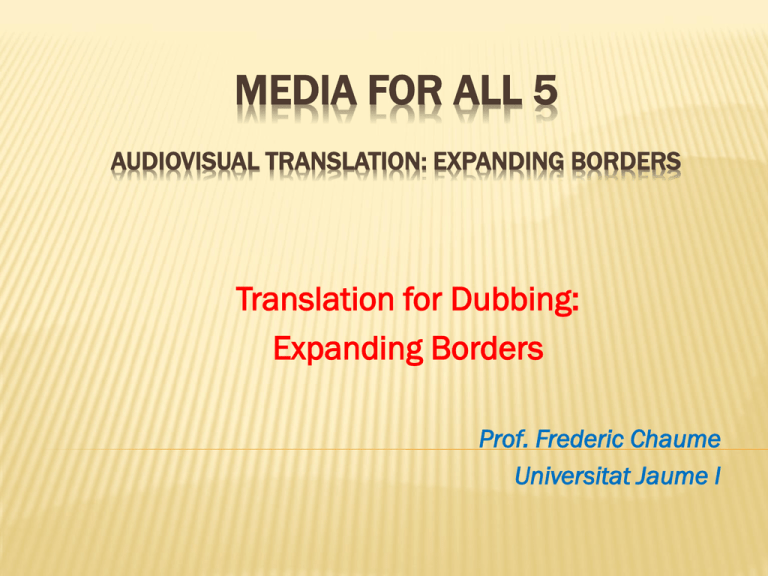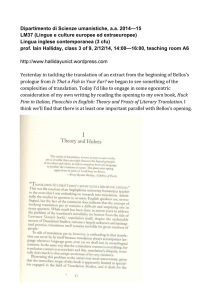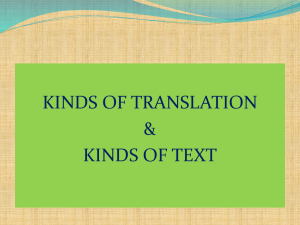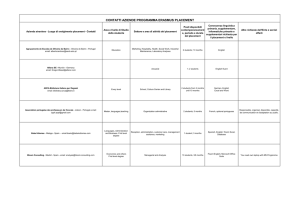
MEDIA FOR ALL 5
AUDIOVISUAL TRANSLATION: EXPANDING BORDERS
Translation for Dubbing:
Expanding Borders
Prof. Frederic Chaume
Universitat Jaume I
1. AUDIOVISUAL TRANSLATION
Revoicing and / or captioning
Revoicing: substitution or addition to the film of
a new soundtrack containing the recorded
dialogues in the target language
Captioning: addition to the film of a new track
containing a written translation of the
dialogues (and in some cases, paralinguistic
signs, sound effects, songs, etc.)
1.1. TYPES OF AUDIOVISUAL TRANSLATION
Spoken output (SL) >
Written output (TL)
Captioning
AVT
Revoicing
Spoken output (SL) >
Spoken output (TL)
1.2. TYPES OF AVT: REVOICING
Revoicing
The original soundtrack is totally
replaced by a new one in the TL
and the target viewer can no
longer hear the original exchanges
-Lip-sync dubbing
-Fandubbing
The translation is overlapped and
the original spoken dialogue is still
audible in the background
Díaz Cintas and Orero (2010: 41)
- Voice-over
- Interpreting
- Free commentary
1.3. AUDIOVISUAL TRANSLATION TYPES:
REVOICING
dubbing
voice-over
Polish szeptanka
(fiction is not always rendered through dubbing/subtitling)
Russian dubbing / partial dubbing
simultaneous interpreting (+ Tanzanian veejays)
free-commentary
Goblin Translation
audio description for the blind and visuallyimpaired
fandubbing/fundubbing (amateurs also dub their own clips)
2. MEDIA CONVERGENCE AND AVT:
PRESENT FACTS
Media convergence + digital technology allow all AVT types in the same
product:
Any audiovisual product, in principle – potentially – can be dubbed,
subtitled (or respoken, or audiosubtitled), voiced-over, subtitled for the deaf,
audiodescribed for the blind. Some other genres can be translated with
free-commentary, can also be fandubbed, fansubbed, etc.
New audiovisual genres combine several AVT Types
videogames (dubbing + subtitling + localization)
advertising & infomercials (dubbing, subtitling, voice-over)
instructional videos, webinars (dubbing + subtitling + voice-over)
We can finally bring technology to its potential:
No more excuses revoicing
and captioning
Media for All
In this new setting...
Which is the situation of
dubbing?
AVT modes on cinema
screens in Europe
http://mediadeskpoland.eu/upload/PP_Comite_media_280708_FINAL.pdf
AVT modes on TV in Europe
http://mediadeskpoland.eu/upload/PP_Comite_media_280708_FINAL.pdf
3. SOME INTERESTING TRENDS: DUBBING
Dubbing is used to translate cartoons all over the world: UK
Portugal Hannah Montana (Chorão 2012); Soundub Lisboa (SDI-Media)
Denmark The Nutty Professor, Dansk Dub, Det Nye Hovedkvarter
Norway teen TV series and films (teen pics) (Tveit 2009)
Russia gradually replacing the once predominant voice-over mode
Greece South American and Turkish soap operas
the Arab world South American and Turkish soap operas
some commercials are dubbed even in traditional subtitling countries
fandubbing is becoming internationally popular
DVDs, DTV and digital technology on the web may include dubbings into
traditional subtitling languages: Crouching Tiger, Hidden Dragon, spaghetti
westerns (dubbed into English)
dubbing is also used to teach foreign languages (Danan, ClipFlair)
Dubbing has also moved into other complex audiovisual translation modes:
in videogame localisation, especially in blockbusters, dialogues are usually
dubbed
SOME EXAMPLES
Lucky Star: http://www.youtube.com/watch?v=rrUhIgdLWCw
Hannah Montana: http://www.youtube.com/watch?v=poxEsv0TWnM
Dansk Dub: http://www.youtube.com/watch?v=kMIRiM5WcpY
Russia: http://www.youtube.com/watch?v=Gptp0vqpzG0
Russia – replacing voice-over: http://www.youtube.com/watch?v=HiSmcG2dOU4
South American soap operas: http://www.youtube.com/watch?v=ItrLJ8xnbnk
(Slovak dubbing): http://www.youtube.com/watch?v=V1oMDLmyA7Q
Turkish soap operas into Arabic: http://www.youtube.com/watch?v=ptJedfuGJtM
Commercials:
http://www.youtube.com/watch?v=3-LavXsgRlw [IT]
http://www.youtube.com/watch?v=4P-nZZkQqTc [EN]
Japan: http://www.youtube.com/watch?v=HBTheJXJEcg
Indonesia: http://www.youtube.com/watch?v=khlIy0OfsmE
Fandub: http://www.youtube.com/watch?v=E-H3K8TK2Vw
VGLOC: http://www.youtube.com/watch?v=9EvP4NWW0T0&feature=related
THE AMERICAS
o
USA
Subtitling
o Dubbing to export (their) films abroad
o
o
Canada
Subtitling in English-speaking regions
o Dubbing in Quebec
o
o
Latin America (general trend)
o Dubbing
on TV
o Subtitling in cinema theatres
ASIA
o
Dubbing countries (mixed modes)
o
o
o
Japan, China (into Mandarin Chinese), Vietnam,
Philippines, India, Pakistan, Thailand
Taiwan and Korea also use mixed modes
Dubbing and subtitling at the same time
(different target languages)
o
o
Korea (dubbing on TV)
Indonesia and Malaysia
Survey in Japan, 2009
How do you usually watch foreign films and programmes?
(according to age)
Total
(n=1269)
48.6%
10-19
(n=212)
40.3%
33.0%
6.9%
50.9%
20-29
(n=211)
50.7%
30-39
(n=211)
7.1%
35.5%
40-49
(n=213)
35.1%
44.5%
50-59
(n=210)
0%
10%
8.5%
34.8%
50.9%
30%
subtitled
dubbed
40%
original version
50%
60%
70%
3.3%
6.7% 2.4%
42.0%
20%
5.7%
5.7% 2.8%
43.7%
56.1%
60-69
(n=212)
9.0%
8.1%
56.4%
4.2%
5.2% 1.9%
80%
90%
100%
never watch foreign films and programs
Source: VLC Co, Ltd. http://www.vlcank.com/mr/report/029/005 (2009)
Survey in Japan, 2009
How do you usually watch foreign films and programmes?
(according to sex)
Men
(n=635)
47.2%
Women
(n=634)
42.0%
50.0%
0%
10%
7.1%
38.6%
20%
30%
subtitled
dubbed
40%
original version
50%
60%
70%
6.6%
80%
90%
3.6%
4.7%
100%
never watch foreign films and programs
Source: VLC Co, Ltd. http://www.vlcank.com/mr/report/029/005 (2009)
Survey in Japan, 2009
Japanese films vs. foreign films
90.0%
80.0%
70.0%
60.0%
50.0%
40.0%
30.0%
20.0%
10.0%
0.0%
Japanese films
Foreign films
4. A PARALLEL PROCESS:
ADAPTATIONS / TRANSCREATIONS (REMAKES?)
A combination of globalisation and localisation:
Glocalisation
Pavitr Prabhakar (Indian Sp)
PowerPuff Girls
Sesame Street
GLOCALISATION INVOLVES TRANSLATION
“Once, American entertainment companies
exporting characters just dubbed them
into other languages. But in recent
years, Asia has become the testing
ground for character reinvention, a
process called "transcreation.” (WSJ)
Glocalization means a case in which a
global product is transformed into
another shape in order to meet the
needs of local consumers.
8. RESEARCH UP TO DATE
THEORETICAL GROUNDS
The audiovisual text from a translation viewpoint (Zabalbeascoa, Sokoli,
Luyken et al., Bartrina, Zhang… based on Film Studies & Semiotics)
Characteristics and ubication of AVT in TS (Reiss, Bassnett, SnellHornby, Hurtado, Zabalbeascoa, Díaz Cintas, Chaume, –concepts–…)
Research methodology (Karamitroglou, Lambert, Díaz Cintas, Díaz
Cintas and Remael, Delabastita, Barambones, Martí Ferriol, Pavesi &
Freddi…)
Lines of research in AVT (Díaz Cintas, Díaz Cintas and Remael, Bartrina,
Mayoral, Gambier, Chaume) and present avenues
AVT History (Izard, Ivarsson, Pommier, Gottlieb, Chaume, Gutiérrez
Lanza, Vandaele, Barambones, Díaz Cintas, Ávila, Pereira, Brant,
Marleau, Qian, Lee, Viviani, Pruys, …)
Audiovisual landscapes (Gambier, Luyken), practices in other countries
and audiovisual cartographies (Barambones)
PROFESSIONAL APPROACHES
Description of professional issues (legal aspects, rates,
deontology, market, industrial process, agents…)
Description of translation process (translation, lip-synching,
take segmentation, insertion of dubbing symbols, imitation
of oral discourse…)
Hesse-Quack, 1969; Fodor, 1976; Pommier, 1988; Luyken et al. 1991, WhitmanLinsen, 1992; Agost, 1999; Chaves García, 2000; Paolinelli & Di Fortunato, 2005;
Spadafora, 2007; Jüngst, 2010;
Description of other revoicing types (voice-over –Orero et
al., Franco, Espasa, Wright and Lallo, Kotelecka, Rebosz…–,
simultaneous interpreting, partial dubbing, videogame
localization, audiodescription, fandubbingcrowdsourcing
...and yet to explore in dubbing
Technology and new tools: 3D, 4D, memory tools, automat
New formats and audiovisual genres the role of dubbing
FOCUSED ON THE SOURCE TEXT
(THE PROCESS OF TRANSLATION)
Constraints (Titford, Mayoral, Zabalbeascoa, Martí
Ferriol…)
Audiovisual Genres (Agost, Luyken, Espasa, Franco)
Pragmatic and discursive approaches (RomeroFresco, Pavesi, Baumgarten, Martínez Sierra,
Richart, Baños, Romero-Ramos)
Prescriptive and contrastive approaches (focused
on ‘bad’ translations, translation problems,
Alcandre, Gómez Capuz, Garcés, Hart, WhitmanLinsen…)
Quality standards in dubbing (moving from ST to
TT): Dries, Chaume, Castro
FOCUSED ON THE TARGET TEXT
(THE PRODUCT OF TRANSLATION) [1]
1.
Filmic adaptations – from novel to film – (Cattrysse, Zatlin,
Cañuelo, Alsina, Igareda,Trasvases Culturales)
2.
Polisystemic approaches: influence of dubbing on in-house
production, on other dubbings, relationship between source
and target cultures, use of dubbed audiovisual products (i.e.
TV station, listings, etc.), generation of new audiovisual
products based on previous dubbings…
3.
Translation Norms in dubbing (from Goris to Ranzato…).
Synchronic or diachronic studies (censorship).
4.
The concept of ‘translation method’ in dubbing (Martí Ferriol,
He)
FOCUSED ON THE TARGET TEXT
(THE PRODUCT OF TRANSLATION) [2]
5.
Translation techniques in dubbing (Chaves, Martí Ferriol,
Minutella, Chaume…)
6.
Corpus studies (Forlì, Trieste…)
7.
The language of dubbing –dubbese–: oral discourse and
language policy (Pavesi, Freddi, Bruti, Minutella, Taylor,
Valentini, Forchini, Izard, Baños, Romero-Fresco,
Matamala, von Flotow, Barambones, TRAMA, Llengua i
Mèdia, CEDIT), neutral languages (Spanish, Portuguese, French)
8.
Filmic approaches and semiotic analysis (Bosseaux,
Martínez Sierra, Richart, Chaume, Chaves, Baumgarten,
Mubenga, Franzelli, González Vera, ), remakes (Zanotti)
9.
Reception studies (Antonini, Chiaro, Antonini & Chiaro,
Espasa, Fuentes, Mayoral…), including audience design
(new audiences, new formats, etc.) and social perspectives
(Luyken, Zaro). Cognitive approaches: eye-tracking
FOCUSED ON THE TARGET TEXT
(THE PRODUCT OF TRANSLATION) [3]
9.
Translation issues (case studies):
humour (Zabalbeascoa, Chiaro, Bucaria, Fuentes, Martínez Sierra,
Martínez Tejerina…)
film titles (González Ruiz, Fuentes, Santaemilia & Soler, Nord…)
songs (Bosseaux, Susam-Sarajeva The Translator, 2008)
advertising (Valdés, Jettmarová, Bueno, Duro, Lorenzo & Pereira)
puns, wordplay and idioms (DelabastitaThe Translator,
Sanderson)
cultural references in dubbing (Franco, Santamaria, Ranzato,
Antonini & Chiaro, Valentini, Martínez-Garrido)
intertextuality (Rodríguez Espinosa, Botella)
pornography (Castillo Flores)
taboo language, linguistic variation (Chiaro…)
proper names (Hurtado de Mendoza, Mayoral)
multilingual movies (Heiss, Valdeón, Corrius, de Higes, de Bonis,
Monti, Vollmer, Zabalbeascoa)
FOCUSED ON THE TARGET TEXT
(THE PRODUCT OF TRANSLATION) [4]
10.10. The Cultural Turn in AVT (and dubbing)
11.Díaz Cintas, 2012 Meta
12.Books, articles and PhD theses:
gender (De Marco, Mereu, Ranzato, Zanotti)
power and manipulation (Di Giovanni, Richart, Ferrari, Barambones
et al., Holobut – voice-over –)
patronage (Marzà, Prats)
...
DIDACTICS
Agost, Chaume, Hurtado (1996 & 1999);
Zabalbeascoa (1997, 1999, 2000, 2001);
Izard (2001); Bartrina & Espasa (2001,
2003); Chaume (2003); Pereira & Lorenzo
(2004); Díaz Cintas (2007); Jüngst (2010);
Martínez Sierra (2012); Cerezo (2012)
Teaching languages through dubbing
(Danan, Burston, ClipFlair)
SOME PROJECTS INVOLVING DUBBING
http://137.204.90.125/dubbingquality
29
Dubbing Quality
www.ehu.es/tralima
Tralima
Forlitx
www.hf.uio.no/ilos/english/research/groups/Voice-in-Translation
35
Voice in Translation
http://centresderecerca.uab.cat/caiac
37
CAIAC
TRANSLATING MUSIC
MANY THANKS!!!!




